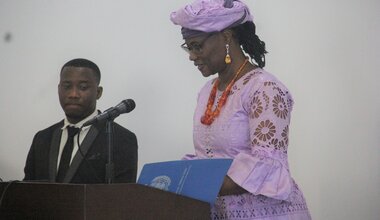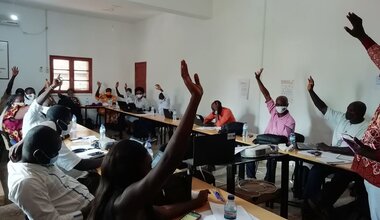Community radio stations in Guinea-Bissau convert to solar energy and gain more broadcast time
When there was no more money to buy fuel, the radio would stop working, "says Abdulai Tama Camara, director of Radio Lamparam, in Iemberem, in the heart of the Catanhez National Park, in the Tombali region. Since the 15 solar panels and eight batteries were installed, the radio benefits from 8 hours of energy, and instead of just one night program, the radio now broadcasts two radio programs a day, from 6 am to 10 pm and from 7 pm to 10 pm. The radio saves fuel money and even managed to open a bank account. It is the radio technicians themselves who maintain the panels to ensure that they are used as long as possible.
Lamparam radio was founded in 1996 by the Association for Development (AD). Today it is the third community radio at the national level. Its broadcast covers the entire border area with Conakry. The radio broadcasts information mainly on nature conservation, agriculture and the environment. It plays a role in sensitizing the community, for example on the prices of raw materials or vaccines. Its journalists produce information in eight languages: Creole, Portuguese Fula, Balanta, Mandinga, Biafada, Susso and Tanda.
This is one of a group of five radios and two community televisions selected, as they are in remote areas where the signal from Radio and National TV from guinea-Bissau does not reach, to benefit from the installation of solar panels, within the scope of a partnership between UN and the National Network of Community Radios and TVs (RENARC). Photovoltaic solar panels allow the production of clean and renewable energy for free, with a smaller ecological footprint. Producing electricity from solar energy reduces the negative impact on the environment, because it avoids spending electricity produced from fossil fuels whose production emits gases such as carbon into the atmosphere.
Guinea-Bissau's community radios and televisions are non-profit organizations, and often face economic difficulties. Most of the employees are volunteers, and still contribute to the operation of the radio. In Guinea-Bissau, radio is the main means of communication, through which citizens receive information about the country's public life, health, education or agriculture. But in some areas neither radio nor national television arrive. Thanks to community radio and television, information is able to cover the entire territory of Guinea-Bissau. They broadcast in several national languages and are a vehicle for promoting national identity. RENARC promotes the union and synergy between the country's 40 community radios and televisions.
The US $ 95,000 project was financed by the United Nations Peacebuilding Fund (PBF), implemented by the United Nations Integrated Office for Peacebuilding in Guinea-Bissau (UNIOGBIS) and the United Nations Program for Development (UNDP). In addition to Rádio Lamparam and TV Massar also in Iemberém, Radio Voz de Quelele, TV Klele and Centro multimedia (Bissau) also benefited from the project; Rádio Sancorla (Cambadju, Bafata region); and Rádio Kossena (Formosa island, Bijagós).
 UN
UN





